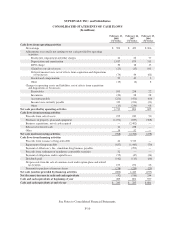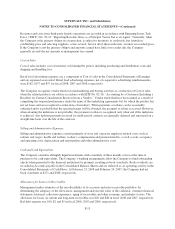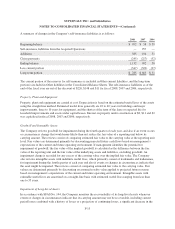Albertsons 2008 Annual Report Download - page 79
Download and view the complete annual report
Please find page 79 of the 2008 Albertsons annual report below. You can navigate through the pages in the report by either clicking on the pages listed below, or by using the keyword search tool below to find specific information within the annual report.SUPERVALU INC. and Subsidiaries
NOTES TO CONSOLIDATED FINANCIAL STATEMENTS—(Continued)
Revenues and costs from third-party logistic operations are recorded in accordance with Emerging Issues Task
Force (“EITF”) No. 99-19, “Reporting Revenue Gross as a Principal Versus Net as an Agent.” Generally, when
the Company is the primary obligor in a transaction, is subject to inventory or credit risk, has latitude in
establishing price and selecting suppliers, or has several, but not all of these indicators, revenue is recorded gross.
If the Company is not the primary obligor and amounts earned have little or no credit risk, the Company
generally records the net amounts as management fees earned.
Cost of Sales
Cost of sales includes cost of inventory sold during the period, including purchasing and distribution costs and
shipping and handling fees.
Retail food advertising expenses are a component of Cost of sales in the Consolidated Statements of Earnings
and are expensed as incurred. Retail food advertising expenses, net of cooperative advertising reimbursements,
were $162, $157 and $57 for fiscal 2008, 2007 and 2006, respectively.
The Company recognizes vendor funds for merchandising and buying activities as a reduction of Cost of sales
when the related products are sold in accordance with EITF No. 02-16, “Accounting by a Customer (Including a
Reseller) for Certain Consideration Received from a Vendor.” Vendor funds that have been earned as a result of
completing the required performance under the terms of the underlying agreements but for which the product has
not yet been sold are recognized as reductions of inventory. When payments or rebates can be reasonably
estimated and it is probable that the specified target will be obtained, the payment or rebate is accrued. However,
when attaining the milestone is not probable, the payment or rebate is recognized only when and if the milestone
is achieved. Any upfront payments received for multi-period contracts are generally deferred and amortized on a
straight-line basis over the life of the contracts.
Selling and Administrative Expenses
Selling and administrative expenses consist primarily of store and corporate employee-related costs, such as
salaries and wages, health and welfare, worker’s compensation and pension benefits, as well as rent, occupancy
and operating costs, depreciation and amortization and other administrative costs.
Cash and Cash Equivalents
The Company considers all highly liquid investments with a maturity of three months or less at the time of
purchase to be cash equivalents. The Company’s banking arrangements allow the Company to fund outstanding
checks when presented to the financial institution for payment, resulting in book overdrafts. Book overdrafts are
recorded in Accounts payable in the Consolidated Balance Sheets and are reflected as an operating activity in the
Consolidated Statements of Cash Flows. At February 23, 2008 and February 24, 2007, the Company had net
book overdrafts of $371 and $388, respectively.
Allowances for Losses on Receivables
Management makes estimates of the uncollectibility of its accounts and notes receivable portfolios. In
determining the adequacy of the allowances, management analyzes the value of the collateral, customer financial
statements, historical collection experience, aging of receivables and other economic and industry factors. The
allowance for losses on current and long-term receivables was $20 and $28 in fiscal 2008 and 2007, respectively.
Bad debt expense was $10, $2 and $5 in fiscal 2008, 2007 and 2006, respectively.
F-13
























